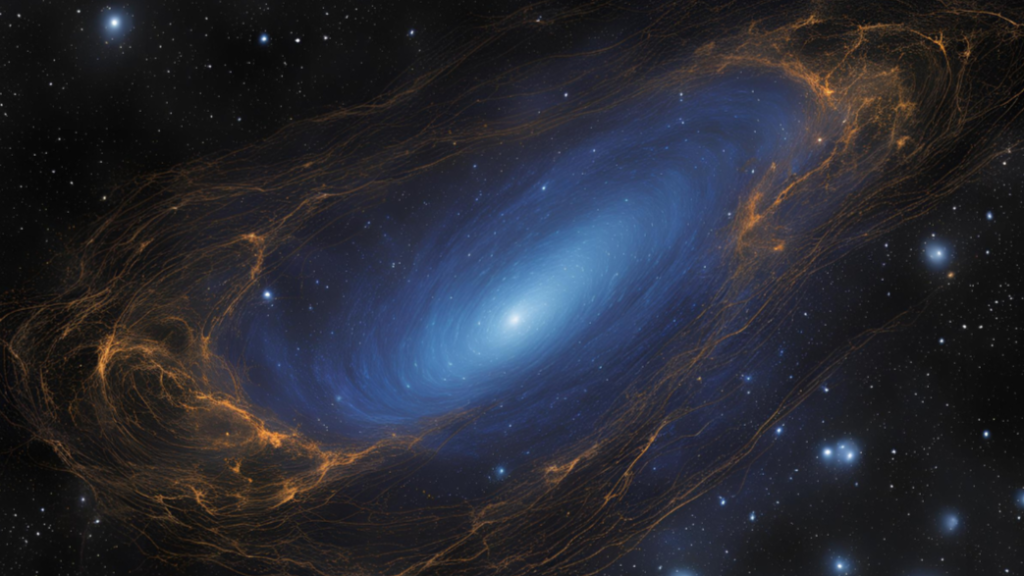INTRODUCTION
Today, we’re diving deep into one of the most mysterious and fascinating topics in modern science: Dark Matter and Dark Energy. These enigmatic components make up about 95% of the universe, yet they remain largely unseen and unexplained. What are they? How do they shape our universe? And why are scientists so keen on uncovering their secrets? Let’s explore!
WHAT IS DARK MATTER?
To understand dark-matter, let’s start with what we see in the universe: stars, planets, and galaxies. These visible objects make up just a tiny fraction of the universe’s total mass. Most of it, around 27%, is dark-matter. But what is it?
Dark-matter doesn’t emit, absorb, or reflect light, making it invisible and detectable only through its gravitational effects. Imagine a game of hide and seek, where the seeker can only find the hidden players by feeling their presence in the dark. This is similar to how scientists infer the existence of dark matter: by observing the gravitational forces it exerts on visible matter.
Dark-matter acts like an invisible hand that holds galaxies together. Without it, galaxies would fly apart due to their own rotation. We see this effect clearly in the rotation curves of galaxies, where stars at the edges move faster than expected, suggesting the presence of an unseen mass.”
WHAT IS DARK ENERGY ?
Now, let’s talk about dark-energy, which is even more mysterious. While dark-matter pulls things together, dark-energy pushes the universe apart. It accounts for about 68% of the universe and is responsible for the accelerated expansion we observe today.
The concept of dark-energy emerged from the observation that distant galaxies are moving away from us faster than those closer to us. This acceleration was unexpected, as gravity should slow down the expansion. Dark-energy, however, is thought to counteract gravity’s pull, causing this acceleration.”
But what exactly is dark-energy? Is it a new force? A property of space itself? Or something else entirely? Scientists are still searching for answers. One popular theory is the cosmological constant, a term introduced by Einstein, which represents a constant energy density filling space. However, this is just one of many theories.”
HOW DO WE STUDY DARK MATTER AND DARK ENERGY?

Studying something we can’t see directly is a challenge, but scientists have developed ingenious methods to investigate dark-matter and dark-energy. For dark matter, they use tools like gravitational lensing, where the gravitational field of a massive object, like a galaxy cluster, bends light from objects behind it. This lensing effect helps map out the distribution of dark-matter.
For dark-energy, scientists use supernovae, the explosive death of stars, as ‘standard candles’ to measure distances in the universe. By comparing the brightness of these supernovae, they can study the rate of expansion and infer the influence of dark-energy.”
Experiments like the Large Hadron Collider and the Dark-Energy Survey are at the forefront of this research, pushing the boundaries of our understanding.”
WHY DOES IT MATTER?
Why should we care about dark-matter and dark energy? These mysteries are not just esoteric topics for scientists. They have profound implications for our understanding of the universe’s fate. Will the universe continue to expand forever? Will it collapse back in a ‘Big Crunch’? Or is there a different destiny awaiting us?
Moreover, the study of dark matter and dark energy could revolutionize physics, leading to new theories that could unify the forces of nature, solve the mystery of gravity, and reveal the true nature of space and time.”
The search for dark matter and dark energy is a journey into the unknown. It’s a quest that pushes the limits of human knowledge and imagination. And who knows, perhaps the answers will unlock new technologies or even lead to new ways of understanding our place in the cosmos.”
As we gaze at the night sky, we’re reminded that there’s so much more to discover. The universe is a vast and wondrous place, full of mysteries waiting to be unraveled. Join us in this cosmic journey by subscribing to our channel, liking this video, and sharing your thoughts in the comments below. Until next time, keep looking up